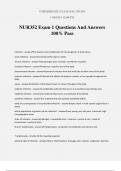©THEBRIGHT EXAM SOLUTIONS
11/8/2024 12:08 PM
NUR352 Exam 1 Questions And Answers
100% Pass
Infection - answer✔the invasion and multiplication of microorganism in body tissue
acute infection - answer✔resolving within days or weeks
chronic infection - answer✔lasting longer than 12 weeks, sometimes incurable
localized infection - answer✔limited to a specific area of the body
disseminated infection - answer✔spread of infection from the initial site to other areas of the body
systemic infection - answer✔infection that affects the body as a whole, or has spread throughout the
body
sepsis - answer✔infections of the blood stream or tissues throughout the body
endemic infection - answer✔a predictable outbreak that occurs in a localized area (chicken pox)
epidemic infection - answer✔an outbreak that occurs at a particular time (ebola)
pandemic infection - answer✔an outbreak that that spreads worldwide (AIDS)
what are consequences of uncontrolled infection? - answer✔septic shock > multi-system organ failure >
death
which populations at greater risk for infection? - answer✔very young, very old, poor, uninsured, high
risk geographic areas
chain of infection - answer✔pathogen > susceptible host > reservoir > portal of exit > mode of
transmission > portal of entry
B and T lymphocytes - answer✔B lymphocytes - production of antibodies and memory cells
T lymphocytes - directly kill the invading organism
physical signs of infection - answer✔fever, inflammations, drainage, pain, malaise, congestion, diarrhea
, ©THEBRIGHT EXAM SOLUTIONS
11/8/2024 12:08 PM
diagnostic tests for infection - answer✔blood cell count - elevate WBC count indicates that an infection
is present
culture
culture and sensitivity - identifies which pathogen is causing infection
radiographic test - xray, MRI, cat scan
preventative measures for infection - answer✔vaccines; food, hand, and patient hygiene, PPE
precautions
pathogen - answer✔a microorganism that causes disease
normal flora - answer✔"healthy" or normal bacteria found in the body
epidemiology - answer✔how diseases spread
virulence - answer✔severity or harmfulness of a disease
opportunistic infection - answer✔infection caused by pathogens that take advantage of an unusual
opportunity - weakened immune system, disrupted microbiota
most common infectious screenings - answer✔STDs in high risk groups
TB in high risk groups
influences of infection/inflammation - answer✔nutrition, tissue integrity, immunity, stress
contact precautions - answer✔gloves, gown, private or cohort room
droplet precautions - answer✔gloves, gown, mask, respirator, private or cohort room
airborne precautions - answer✔negative pressure airflow, mask, respirator, private room
protective environment - answer✔positive pressure airflow with filtration, private room, mask to be
worn when exiting room
measles, chickenpox (varicella), disseminated varicella zoster, pulmonary or laryngeal tuberculosis
require which type of precautions? - answer✔airborne precautions
Diphtheria (pharyngeal), rubella, streptococcal pharyngitis, pneumonia or scarlet fever in infants and
young children, pertussis, mumps, Mycoplasma pneumonia, meningococcal pneumonia or sepsis,
pneumonic plague require which type of precautions? - answer✔droplet precautions
, ©THEBRIGHT EXAM SOLUTIONS
11/8/2024 12:08 PM
Colonization or infection with multidrug-resistant organisms such as VRE and MRSA, Clostridium difficile,
shigella, and other enteric pathogens; major wound infections; herpes simplex; scabies; varicella zoster
(disseminated); respiratory syncytial virus in infants, young children, or immunocompromised adults
requires which type of precautions? - answer✔contact precautions
Allogeneic hematopoietic stem cell transplants require what type of precautions? - answer✔protective
environment
What is the most effective way to control transmission of infection?
1. Isolation precautions
2. Identifying the infectious agent
3. Hand hygiene practices
4. Vaccinations - answer✔3. hand hygiene practices
A patient who has been isolated for Clostridium difficile (C. difficile) asks you to explain what he should
know about this organism. What is the most appropriate information to include in patient teaching?
(Select all that apply.)
1. The organism is usually transmitted through the fecal-oral route.
2. Hands should always be cleaned with soap and water versus alcohol-based hand sanitizer.
3. Everyone coming into the room must be wearing a gown and gloves.
4. While the patient is in contact precautions, he cannot leave the room.
5. C. difficile dies quickly once outside the body. - answer✔1, 2, 3
Your assigned patient has a leg ulcer that has a dressing on it. During your assessment you find that the
dressing is saturated with purulent drainage. Which action would be best on your part?
1. Reinforce dressing with a clean, dry dressing and call the health care provider.
2. Remove wet dressing and apply new dressing using sterile procedure.
3. Put on gloves before removing the old dressing; then obtain a wound culture.
4. Remove saturated dressing with gloves, remove gloves, then perform hand hygiene and apply new
gloves before putting on a clean dressing. - answer✔4
A patient is diagnosed with methicillin-resistant Staphylococcus aureus (MRSA) pneumonia. Which type
of isolation precaution is most appropriate for this patient?
1. Reverse isolation
2. Droplet precautions




